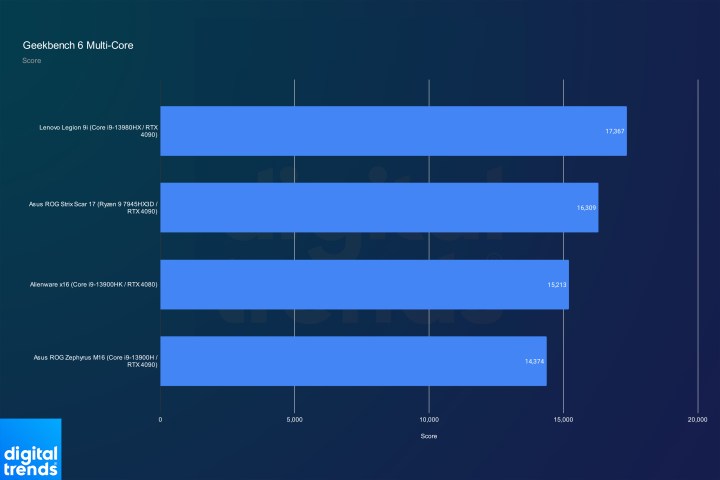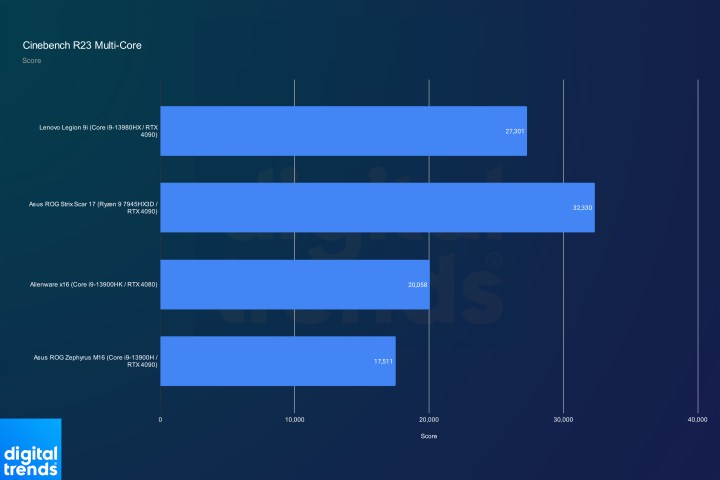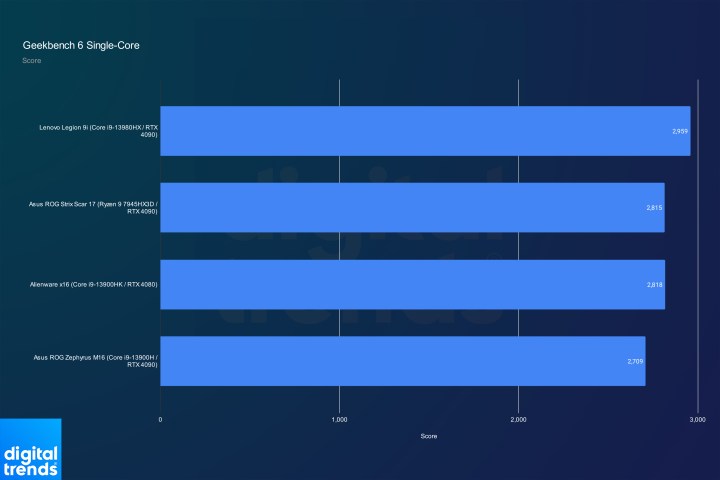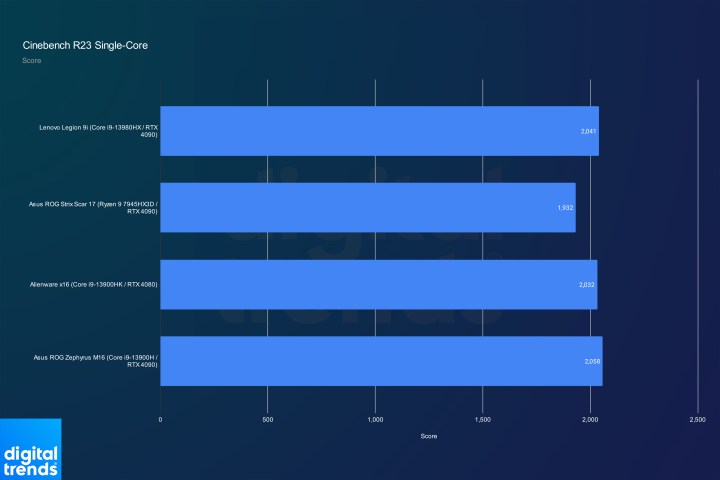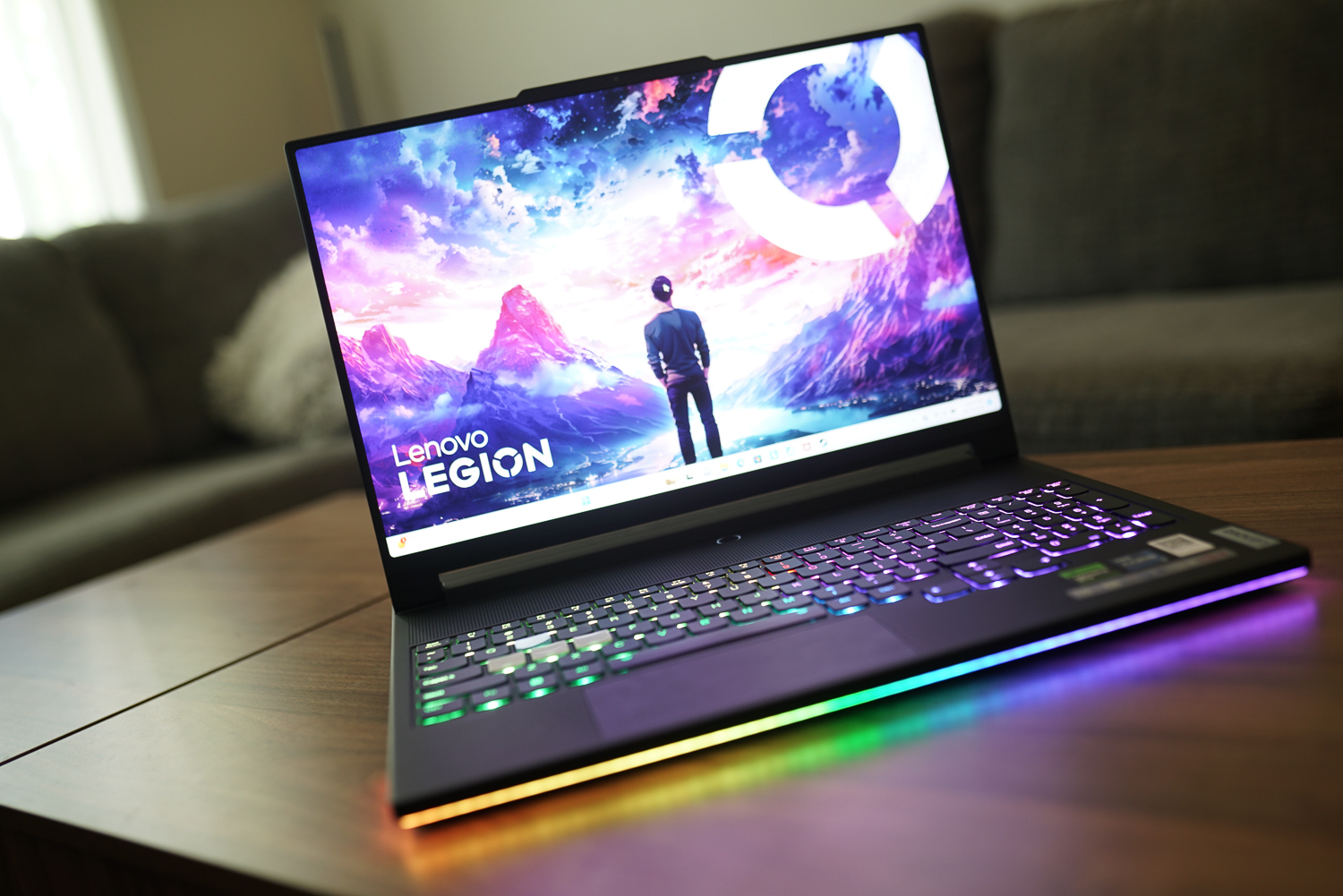
Lenovo Legion 9i
MSRP $3,420.00
“There’s no gaming laptop that can touch the Lenovo Legion 9i.”
Pros
- Desktop replacement levels of performance
- Support for both USB-C and GaN charging
- Gorgeous mini-LED display
- Surprisingly portable
- Excellent keyboard
Cons
- Poor battery life
- Trackpad is too small
I don’t hand out perfect scores lightly. But trust me — the Lenovo Legion 9i earns it.
Lenovo is no stranger to the list of the best gaming laptops, but its Legion 9i immediately sounded like it wouldn’t make the cut. A high-end, RTX 4090-packing 16-inch laptop that’s main claim to fame is a liquid cooling system? Sounds interesting, but not something that could be worth thousands of dollars. Fortunately, the Legion 9i doesn’t live or die on the success of its marquee feature.
The liquid cooling certainly helps, but more importantly, the Legion 9i is a masterc lass in how you make a true desktop replacement. It’s a laptop that balances being powerful enough to replace your desktop and being practical enough to serve as your laptop. While most gaming laptops focus on one extreme or the other, the Legion 9i somehow manages to find the perfect middle ground — all while never skipping a beat in performance.
Lenovo Legion 9i (2023) specs
| Lenovo Legion 9i (2023) | |
| Dimensions | 0.75 x 14.08 x 10.93 inches |
| Weight | 5.51 pounds |
| Processor | Intel Core i9-13980HX |
| Graphics | Nvidia RTX 4090 (150W) |
| RAM | 32GB DDR5-5600 |
| Display | 16-inch, 3,200 x 2,000, 1,200 nits, mini-LED, 165Hz |
| Storage | 2TB |
| Touch | N/A |
| Ports | 2x Thunderbolt 4 (140W, DisplayPort), 2x USB-A 3.2 Gen 1, 1x HDMI 2.1, 1x Ethernet, 1x SD card reader, 1x 3.5mm headphone jack |
| Wireless | Wi-Fi 6E, Bluetooth 5.1 |
| Webcam | 1080p |
| Operating system | Windows 11 Home |
| Battery | 99.99 Whr |
| Price (as configured) | $3,970 |
Breaking down the specs of the Legion 9i is a bit easier than it is withother Lenovo machines. This is one of the most premium laptops you can buy, and Lenovo restricts the configuration options to keep the laptop focused at the high end.
The base configuration clocks in at $3,420, and for that, you get 1TB of PCIe Gen4 storage, an Intel Core i9-13980HX CPU, an Nvidia RTX 4080 GPU, and 32GB of DDR5-5600 memory. That’s a little more pricey than competing laptops like the Alienware x16, which come in around $3,000 for a similar configuration.
You can step things up and extend the storage up to 3TB, split across 2TB and 1TB drives — and you also get 64GB of memory and an RTX 4090 GPU. Maxed-out, the machine clocks in at $4,090. That’s around $800 more than a similar configuration of the Alienware x16 and around $400 more expensive than the Asus ROG Strix Scar 16. However, this configuration is $200 cheaper than the Razer Blade 16, and that laptop comes with half the memory.
Regardless, this is a very expensive laptop. There are some machines like the Razer Blade 16 and MSI GT77 Titan that are more expensive, but there are also plenty of options that are cheaper than the Legion 9i that pack the same specs. The Legion 9i justifies its higher price in a handful of ways, though, which I’ll get to throughout this review.
One of those ways is liquid cooling. The laptop includes a liquid cooling system that was co-engineered with Cooler Master. It runs over the GPU VRAM, but it doesn’t run at all times. Instead, Lenovo says it kicks in when the GPU hits 84 degrees Celsius to cool everything down.
That design should give you an idea about what the liquid cooling is built for. It’s not to keep the laptop cooler and quieter than other gaming machines — though the Legion 9i certainly isn’t overly hot or loud. The real point is to keep the profile thin. As I’ll get to next, the Legion 9i is surprisingly portable given how powerful it is. The liquid cooling helps it stay that way, much unlike monstrous gaming laptops along the lines of the GT77 Titan.
Lenovo Legion 9i: design
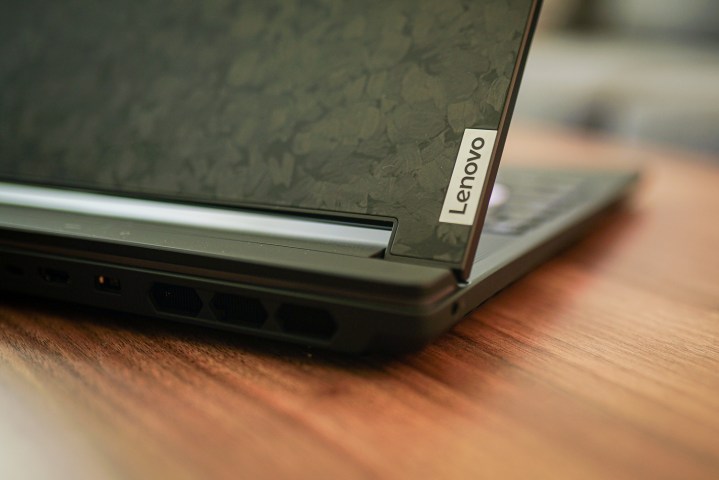
I’ve never seen a laptop quite like the Lenovo Legion 9i. The overall body is very similar to the 16-inch Lenovo Legion Pro 5, with a small heat sink at the back that doubles as a hub for all of your connections. It’s the top cover that’s unique.
It looks like some avant-garde camo pattern, or like someone took various shades of gray paint and haphazardly swiped them across the lid. There’s a bit of texture to them, too, though not enough that it’s off-putting. Lenovo says each design is unique, and although it’s not an aesthetic I’d normally gravitate toward, I’m oddly enamored with the Legion 9i.
RGB is on full display here, not only on a per-key basis with the keyboard, but also on diffused LED strips that run around the front and back of the laptop. Lenovo even went out of its way to add RGB to the logo on the lid. Thankfully, you can turn all of this off with a keyboard shortcut, but it looks nice all lit up.
The Legion 9i is the most portable 16-inch gaming laptop I’ve seen.
What’s most surprising about the Legion 9i’s design, though, is its size. Despite packing the most powerful hardware money can buy, it’s a far cry from machines like the behemoth MSI GT77 Titan. It clocks in at just 0.75 inches thick and 5.51 pounds. That’s about as thick as the Alienware x16, and half a pound lighter. Lenovo nearly matched the thickness of the Razer Blade 14, though the Legion 9i comes in more than a pound heavier.
No 16-inch laptop is portable, but by the standard of laptops in the desktop replacement class, the Legion 9i is the most portable laptop I’ve seen. It certainly helps that Lenovo includes a 140-watt USB-C charger so you don’t have the carry around a massive power brick with the laptop. This is still a large gaming laptop, but every time I used the Legion 9i, I was continually shocked at how powerful it was given the size.
Lenovo Legion 9i: ports
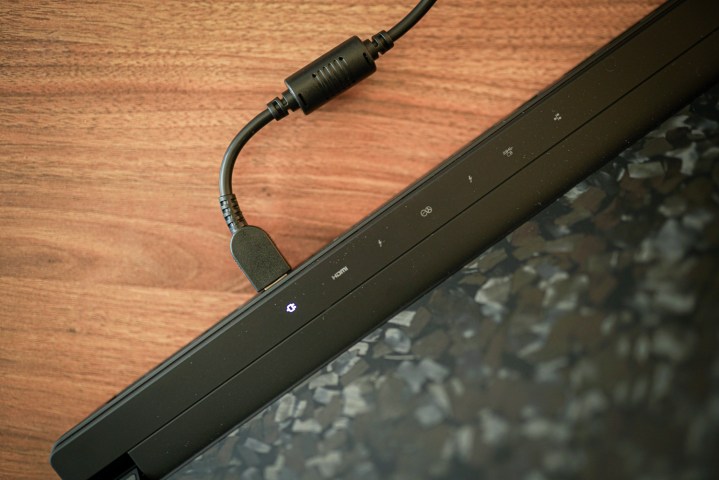
Lenovo continues to have the best balance of ports you can find on a gaming laptop. Most of the connections are situated at the back of the machine, similar to the Asus ROG Strix G17. There, you get a pair of Thunderbolt 4 ports that support DisplayPort 1.4 and up to 140W of power delivery, along with full-sized Ethernet, a USB-A 3.2 Gen 1 port, full-size HDMI 2.1, and the power connector. Lenovo also includes some ports on the sides. There’s a sole USB-A 3.2 Gen 1 port on the right, along with a 3.5mm headphone jack and a full-size SD card reader on the left.
Lenovo Legion 9i: keyboard and trackpad
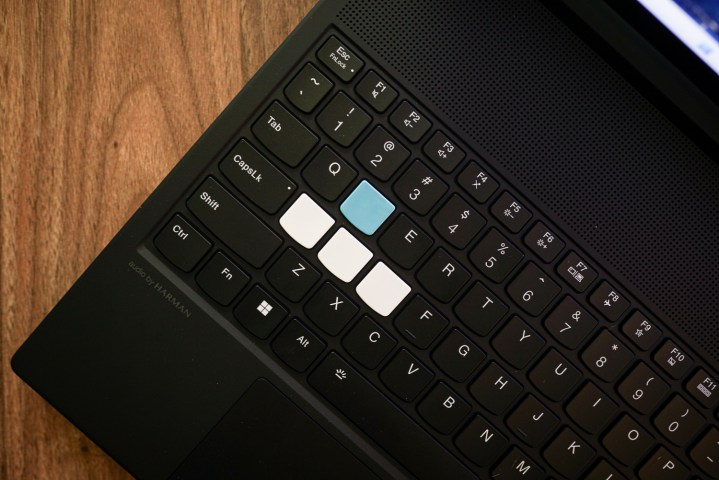
The keyboard on the Legion 9i is the same one you’ll find on other Lenovo laptops — that is to say it’s one of the better gaming laptop keyboards you can find. It’s snappy, with just enough key travel and solid spacing between keys. I prefer slightly more travel for typing, like you’ll find on Asus laptops, but for gaming, Lenovo’s Legion keyboard has it nailed.
This one is bit unique, though. It’s the same keyboard, but Lenovo includes a small kit with eight replaceable keycaps. This is the first laptop that I’m aware of that comes with replaceable keycaps. The included set includes four white keycaps and a collection of four pastel shades, but they feature a glossy finish, unlike the matte finish on the rest of the keyboard. It’s a cool idea, but it would be a truly unique feature if Lenovo could back up the functionality with keycap sets.
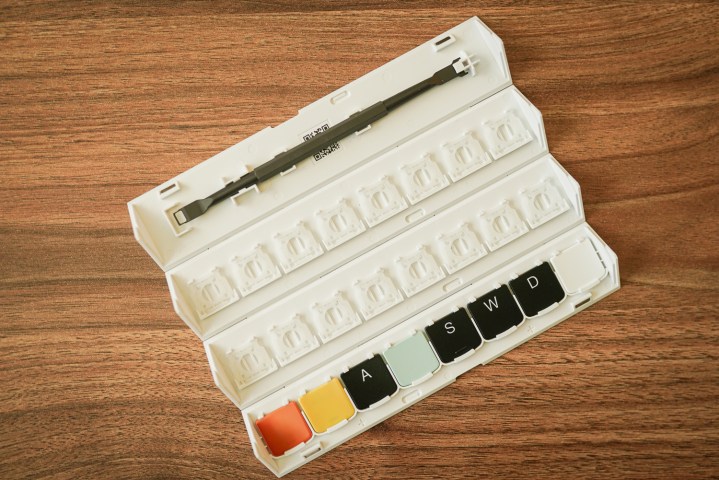
The keyboard is great. The trackpad is a different story. If there’s one major gripe I have with the Legion 9i, it’s how small the trackpad is. Similar to the Alienware x14 R2 and x16, there are vents at the top of the key deck, which causes the keyboard and trackpad to be pushed down toward you. The trackpad suffers here, as it’s cramped on the edge of the Legion 9i. I constantly found myself flying off the trackpad, which is a shame.
Lenovo Legion 9i: display

The Legion 9i might have the best laptop display I’ve seen. The only other machine in the running is the Asus ROG Zephyrus M16 with its mini-LED display, but Lenovo’s is just as good, if not a little better. It deploys mini-LED for searing brightness and one of the best HDR images you can find in a laptop. Short of an OLED gaming laptop — and there aren’t many out there — this is the best image you’re going to find on a gaming machine.
Let’s start with some basic specs. This is a 16-inch, 16:10 display with a very odd resolution: 3,200 x 2,000. Lenovo calls that 3.2K, and it works out to a pixel density of 236 pixels per inch (ppi). That’s ahead of the Surface Laptop Studio 2 and just behind the MacBook Pro 14, so you’re getting a very sharp display that can hang with even high-end mainstream laptops.
That’s actually the least interesting part of the display, though. Lenovo claims it can reach a peak brightness of 1,200 nits, and it’s certified with VESA’s DisplayHDR 1000. I measured a peak brightness of 606 nits, but that was for a much larger portion of the screen. Regardless, that’s still leagues ahead of what you’ll find with most laptops.

Lenovo is able to achieve such heights with mini-LED, which enables 1,536 local dimming zones on the display. It works, too. Lenovo advertises a contrast ratio of 1,000,000:1, and although I measured it at 750,000:1, it really doesn’t matter. The display produced perfect black levels, meaning you have an extremely high contrast ratio that’s exceptional for HDR.
The trade-off here is color accuracy. The display covered 100% of the sRGB color space and 97% of the extended DCI-P3 space, but it came with a color error of 2.6. Ideally, you want to see an error under 2. With calibration, this is a showstopping creator display, but it’s clearly tuned for gaming and media consumption out of the box.
Lenovo Legion 9i: CPU performance
The Core i9-13980HX inside the Legion 9i is Intel’s most powerful laptop CPU that’s currently available. It’s a 24-core chip that comes with eight performance cores and 16 efficiency cores for a total of 32 threads, and it can clock to 5.6GHz. My benchmarks show it’s still a monster CPU, even if AMD’s Ryzen 9 7945X3D can put up some impressive numbers itself.
Starting with Geekbench 6, you can see the massive core count in the Legion 9i beat out everything in multi-core performance. That doesn’t translate to Cinebench R23, however, where the more powerful cores available in the Strix Scar 17 win the test by a decent margin. The Legion 9i is still ahead of everything else, though.
Single-core performance is a different story. Intel dominates here, especially in Geekbench 6. The Legion 9i topped the chart in both of these tests, though the other Intel chips are close in Cinebench.

How does that translate into real-world performance? The Legion 9i can’t best the Strix Scar 17 in Premiere Pro, but it’s still miles ahead of a high-end mainstream laptop like the Lenovo ThinkPad P1 Gen 6.
You can go further, too. Through Lenovo Advantage, you have options to overclock the CPU and GPU for higher performance, and they’re already topping the charts.
Lenovo Legion 9i: gaming performance
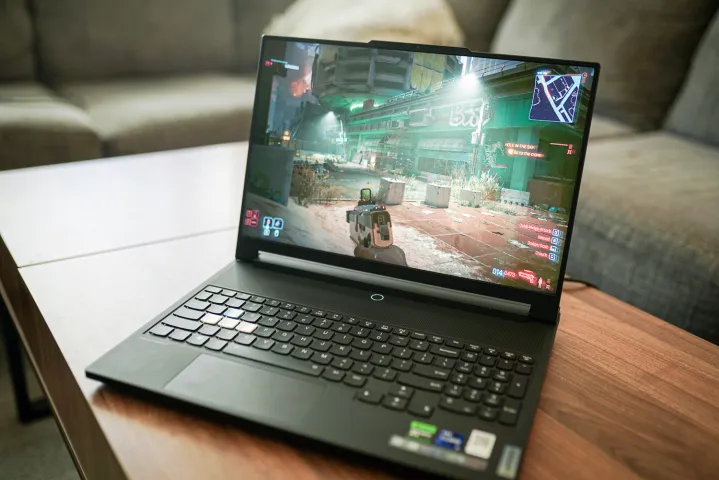
The Lenovo Legion 9i is a gaming laptop first and foremost — and one of the fastest I’ve ever tested. For comparison, look at the 3DMark Time Spy chart below. The Legion 9i managed a higher core than even the Asus Scar 17 with the Ryzen 9 7945HX3D, which was previously the fastest gaming laptop we tested.

What’s surprising about this performance isn’t that it can compete with top laptops like the Scar 17, but that the Legion 9i does so while being smaller and lighter. The liquid cooling may seem like a marketing gimmick, but it allows the Legion 9i to truly enter the class of a desktop replacement without ever feeling like one.
Lenovo takes advantage of all that power, too. Rather than using a fast 1080p screen or a slow 4K one, the Legion 9i feels perfectly tuned with its 3.2K display. In the Balanced mode, you’re looking at above 60 frames per second (fps) with all the settings maxed out, even in games like Cyberpunk 2077. In Performance mode, the laptop usually gets above 100 fps. That’s seriously impressive performance considering this resolution.

It’s so much performance that ray tracing becomes a real possibility. In Returnal, you can turn max out everything, including ray tracing, at native resolution while still hitting 90 fps. Cyberpunk 2077 is delivering 27 fps. That’s not playable on its own, but that’s about as fast as a desktop RTX 4080 at 4K.
You have Nvidia’s Deep Learning Super Sampling 3 (DLSS 3) available here, too. With DLSS 3, Cyberpunk 2077 also reaches up to 90 fps. I even tried out Cyberpunk 2077‘s extremely demanding path tracing mode with DLSS 3 and hit above 60 fps. That was completely maxed out, and included Nvidia’s new Ray Reconstruction feature.

The Legion 9i doesn’t make you sacrifice performance for how portable it is. It’s one of the fastest gaming laptops I’ve tested, and it can even put most desktop PCs to shame. More importantly, the laptop doesn’t sacrifice in other areas to hit its performance targets. It’s a fantastic gaming experience if you’re using the laptop itself, as well as a top-shelf gaming experience if you hook up an external monitor with the HDMI 2.1 port.
Lenovo Legion 9i: battery life
With how much power the Legion 9i has on tap, it shouldn’t come as a surprise that its battery life suffers. In our web-browsing test, the machine lasted just two-and-ahalf hours away from the charger, which is among the lowest scores we’ve recorded. It doesn’t come as a shock, though.
It’s almost the exact same battery life I saw with the Asus Scar 17, and about half an hour less than the Alienware x16. Not only is the Legion 9i packing the most power-hungry components from Nvidia and Intel, it’s also using an extremely bright mini-LED display. That’s going to tank the battery life.
It shouldn’t come as a surprise that this laptop’s battery life isn’t its strength.
A feather in the Legion 9i’s cap is the fact that the laptop ships with two chargers. You have the massive 330W GaN charger that you’ll want to plug in for gaming sessions, but also a portable 140W USB-C charger that’s plenty fast for topping off the machine. I love the dual functionality on display here, giving you portability and power by not relying on a single port or charger.
The 140W USB-C charger won’t unlock the full power of the Legion 9i, but it’s still enough power to allow you to play lighter games on the go.
Lenovo Legion 9i: verdict
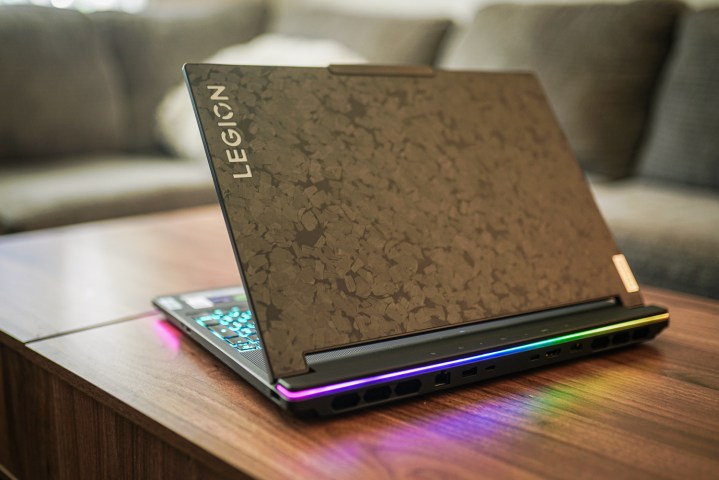
I’ve reviewed a ton of gaming laptops, many of which fall into the category of desktop replacement and cost over $3,000. I’ve never reviewed a gaming laptop that actually felt worth that price, though. There was always a catch, and it felt like you were paying for the diminishing returns of high-end hardware.
The Lenovo Legion 9i is an exception. It’s the first high-end laptop I’ve ever touched that truly feels worth its premium price point. It focuses on being a good laptop as much as it focuses on peak performance, and it exceeds on both fronts.
There are a couple of very minor cons here. First, the trackpad is a bit too small, and that’s probably my biggest issue with the Legion 9i. The color accuracy out of the box isn’t great, either, but I’ll take that given the incredible HDR experience the display offers. That’s the most I can come up with, and those are very minor complaints wen you take into account how much else the Legion 9i has to offer. It’s an exceptional laptop, and if you find yourself in the position of needing a true desktop replacement, this is the one to buy.
Editors’ Recommendations


